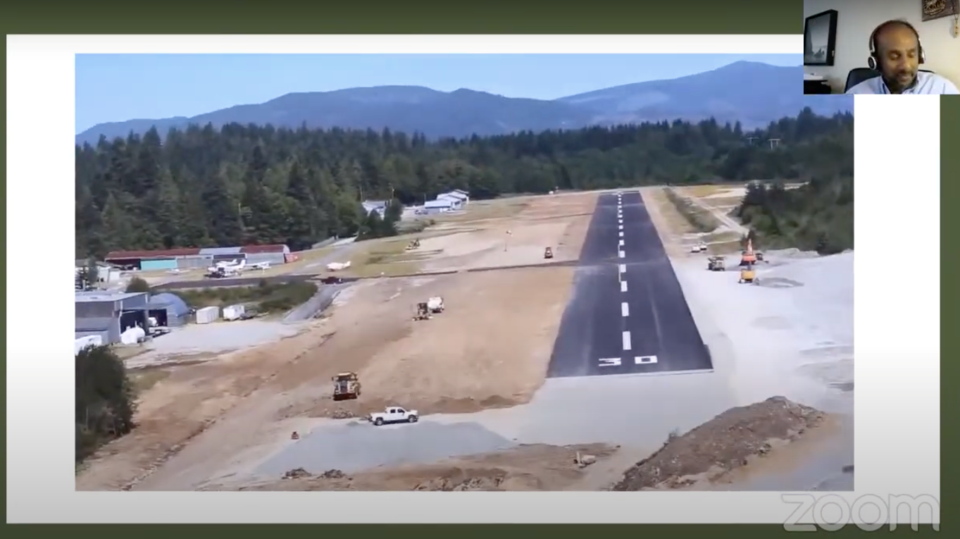Funding to improve lighting at the airport became a flashpoint at a District of Sechelt council meeting as councillors debated moving ahead with an expensive installation that wasn’t accounted for in grant applications.
Ultimately, council voted to move ahead with a spending scheme of $381,187 from the Community Works Fund Reserve, $158,856 from airport contingency and $64,000 in COVID-19 restart grant funding for a total of $604,044 to add new medium-intensity lighting to the Sechelt Airport.
It is expected to take four months to install the lighting and the airport won’t be available for nighttime flights until the project is complete.
Over the last couple of years, the district has received $2,388,703 in grant funding to expand and resurface the airport runway to a total length of 3,100 feet. The district also earmarked $796,234 of Gas Tax funds from its Community Works Fund for the purpose.
Expansion is now largely complete and the airport reopened June 22. The project came in under budget, according to staff.
As part of the grant application process, the district earmarked $30,000 to add lighting conduits along the runway, but didn’t budget to upgrade or install new lights.
“This was a cost control measure to increase the likelihood of being awarded the grant,” the staff report said. “At the time of the grant application, the intention was that the expansion of the lighting system could be completed via volunteer installation or through a future grant opportunity.”
However, the current low-level lighting system doesn’t meet Canadian Aviation Regulations and the runway plan includes replacing the old, obsolete system with a Precision Approach Path Indicator (PAPI) system.
At the July 7 regular council meeting, staff and Associated Engineering presented five options to council, including to use available funding to install conduits only and leave the purchase and installation of lights until the district could find other grant funding for the job.
Other options included what they ultimately approved – spending $604,044 for medium-intensity lights, which is the only option that would meet requirements for a certified airport as opposed to an aerodrome.
Technically, the facility is registered as an aerodrome and can meet a lower lighting standard than if it were a certified airport, but the consultants recommended moving ahead with lighting that would satisfy certified airport requirements to save money in the future, assuming the district moves forward with certification, which would allow for commercial flights, and which is part of the district’s development plans.
Solar lighting was also considered as an option but was more than $55,000 more expensive than the medium-intensity option. Extending existing low-intensity lighting for roughly $528,000 was another option.
They also presented the cheaper option of retroreflective markers, which would cost $281,869, but are considered a “stop gap” measure by consultants. This became the preferred approach for both councillors Alton Toth and Matt McLean.
The consultants said using reflective markers is “pretty rare,” and they have never seen them on an airport runway in B.C.
McLean, meanwhile, opposed the more expensive option because a business strategy isn’t in place and suggested moving forward with retroreflective markers in the interim.
Toth noted the district deferred two years of its road paving program to have the Gas Tax money for the project. “That’s fine, because that was work that very much needed doing,” he said.
“However, we sure could use that Gas Tax funding to catch up on our road paving this year. We’ve got sewer infrastructure that’s crumbling, we’ve got all sorts of projects that could use that money.”
Toth made the motion to move ahead with the retroreflective marker option, but that failed, since only he and McLean voted in favour of it.
Mayor Darnelda Siegers spoke in favour of medium-intensity lighting. “It’s taken us a long time to get to this place, and I think we need to set this up for whatever comes next, and I’m not willing to spend $280,000 and then have to come back and put in a lot more money down the road to take out what we’ve put in now. I want it done,” she said.
Coun. Eric Scott also opposed retroreflective lighting, citing his 30-year career as a commercial pilot. “I’ve flown all over Canada. I’ve landed on runways with retroreflective markers, I’ve landed on runways that had burn pots, I’ve landed on runways that have had nothing but skidoos running down the side. It’s an elevated level of risk and I’m absolutely not interested in reflective lighting. It might meet a standard but it’s still dangerous. I just won’t support it,” he said.
He moved the fourth option, which Toth and McLean opposed.
During the meeting Siegers justified using $64,000 from the COVID-19 restart funds because the equivalent amount was charged by Jakes Construction on COVID-19 mitigation measures during the expansion project.



